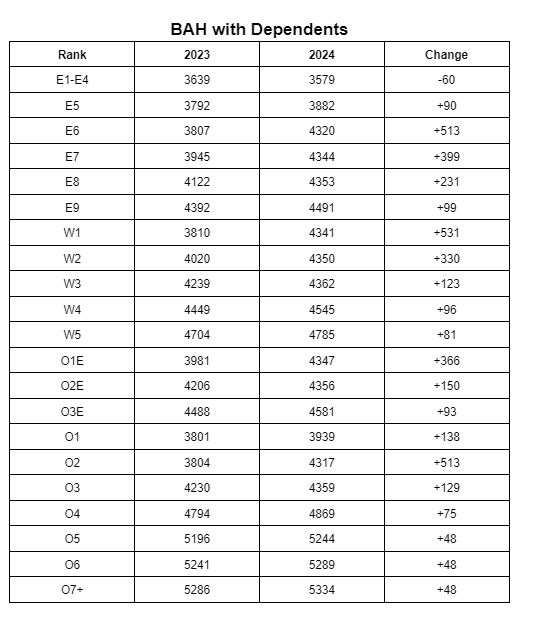
Most U.S. Navy sailors and officers will see an increase in their basic allowance for housing (BAH) next year, with the exception being the lowest enlisted sailors.
Sailors ranked E1-E4 with dependents will receive $3,579 to cover housing in 2024, which is $60 less than the 2023 rate. Without dependents, sailors will see a $40 decrease in BAH, although most sailors of that rank without dependents would be assigned to barracks housing.
The decrease will only impact sailors stationed in San Diego County beginning in 2024. Those who already live here are grandfathered into the higher rate under the military’s provision of individual rate protection.
Conversely, E6 sailors and O2 officers with families will pocket an additional $513 monthly starting in January.
Other ranks saw more modest increases, with the average increase at $208.
At press time, the U.S. Navy had not responded to requests for comment on why the rate decreased for E1 to E4 personnel. However, the Department of Defense said in a statement that it collects rental data for 300 military housing areas in the United States to determine appropriate BAH.
“The Basic Allowance for Housing rate-setting process relies on a wide variety of data sources (e.g., U.S. Census Bureau survey data, Bureau of Labor Statistics Consumer Price Index, commercial subscription rental cost databases, industry-leading online rental listing websites, and input from the services and local military housing offices, among other sources) to obtain high-quality, accurate, current-year housing cost data,” the statement reads.
Rent has increased in San Diego by 4% over the last year, according to Zumper, which analyzes rental market trends. The median rent for a three-bedroom unit in San Diego is $3,950 monthly.
In Coronado, a three-bedroom unit carries a median rent of $5,995, which is higher than the BAH for even the Navy’s top officers.
But the 2024 BAH rates aren’t meant to cover all housing costs; the DOD continued the service member cost-sharing element at 5% percent of the national average housing cost by pay grade.
A cost-saving option for families is to live in the military’s privatized government housing, which in San Diego is run by Liberty Military Housing. Those homes usually cost full BAH, but utilities are included and the units are generally larger than what a family could find in the local economy for their allowance.
However, some question the quality of the housing, and waitlists for placement stretch months, so base housing is not always an option for relocating Navy personnel and their families.
A report from LMI Government Consulting found a swift uptick in the number of families finding housing in the private sector – whether through local rentals or purchases – beginning in the late 1990s.
“The Department of Defense relies on the local community to provide the majority of housing occupied by military personnel and their families,” writes Military OneSource, a DOD-run website. “Since military family housing is only built when there is a shortage of suitable, affordable housing in the private sector, most military families live in off-base rental or privately-owned properties. In San Diego, 80% of military families live in housing in the private sector.”
New BAH rates, along with current rates, are outlined below.
Megan Kitt is married to an active duty service member.






